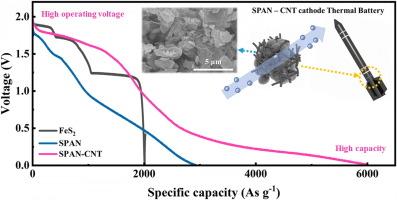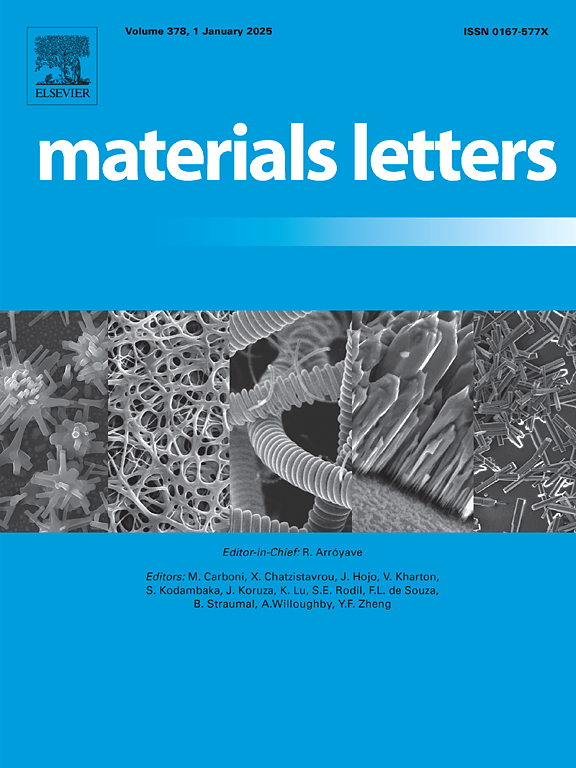用涡轮静压碳基质和碳纳米管封装硫,以提高热电池的容量和工作电压
IF 2.7
4区 材料科学
Q3 MATERIALS SCIENCE, MULTIDISCIPLINARY
引用次数: 0
摘要
热电池对更高能量和功率密度的需求要求开发先进的正极材料。虽然硫提供了很高的理论容量,但它的低导电性和热不稳定性限制了它的实际应用。在此,我们提出了一种SPAN- cnt复合阴极,其中包含嵌入聚丙烯腈(SPAN)衍生的涡层碳基体中的硫,并均匀包裹碳纳米管(CNTs)。该复合材料通过渗透碳纳米管网络获得了高导电性(0.39 S cm−1),并且由于强共价SC键,其热稳定性高达500°C。在热电池测试中,pan - cnt阴极的开路电压为2.0 V,高于传统的FeS2 (1.9 V)。它提供5972 As g−1的高容量,大大超过了FeS2 (2006 As g−1)。这些结果强调了pan - cnt作为下一代高性能热电池阴极的潜力。本文章由计算机程序翻译,如有差异,请以英文原文为准。

Encapsulating sulfur with a turbostatic carbon matrix and carbon nanotubes for enhanced capacity and operating voltage in thermal batteries
The demand for higher energy and power densities in thermal batteries necessitates the development of advanced cathode materials. Although sulfur offers a high theoretical capacity, its low electrical conductivity and thermal instability limit its practical use. Herein, we present a SPAN-CNT composite cathode, comprising sulfur embedded in a turbostratic carbon matrix derived from polyacrylonitrile (SPAN) and uniformly wrapped with carbon nanotubes (CNTs). The composite achieves high conductivity (0.39 S cm−1) through a percolating CNT network and exhibits thermal stability up to 500 °C due to strong covalent S![]() C bonding. In thermal battery tests, SPAN-CNT cathode exhibits an open-circuit voltage of 2.0 V, higher than that of conventional FeS2 (1.9 V). It delivers a high capacity of 5972 As g−1, significantly surpassing FeS2 (2006 As g−1). These results underscore the potential of SPAN-CNT as a next-generation cathode for high-performance thermal batteries.
C bonding. In thermal battery tests, SPAN-CNT cathode exhibits an open-circuit voltage of 2.0 V, higher than that of conventional FeS2 (1.9 V). It delivers a high capacity of 5972 As g−1, significantly surpassing FeS2 (2006 As g−1). These results underscore the potential of SPAN-CNT as a next-generation cathode for high-performance thermal batteries.
求助全文
通过发布文献求助,成功后即可免费获取论文全文。
去求助
来源期刊

Materials Letters
工程技术-材料科学:综合
CiteScore
5.60
自引率
3.30%
发文量
1948
审稿时长
50 days
期刊介绍:
Materials Letters has an open access mirror journal Materials Letters: X, sharing the same aims and scope, editorial team, submission system and rigorous peer review.
Materials Letters is dedicated to publishing novel, cutting edge reports of broad interest to the materials community. The journal provides a forum for materials scientists and engineers, physicists, and chemists to rapidly communicate on the most important topics in the field of materials.
Contributions include, but are not limited to, a variety of topics such as:
• Materials - Metals and alloys, amorphous solids, ceramics, composites, polymers, semiconductors
• Applications - Structural, opto-electronic, magnetic, medical, MEMS, sensors, smart
• Characterization - Analytical, microscopy, scanning probes, nanoscopic, optical, electrical, magnetic, acoustic, spectroscopic, diffraction
• Novel Materials - Micro and nanostructures (nanowires, nanotubes, nanoparticles), nanocomposites, thin films, superlattices, quantum dots.
• Processing - Crystal growth, thin film processing, sol-gel processing, mechanical processing, assembly, nanocrystalline processing.
• Properties - Mechanical, magnetic, optical, electrical, ferroelectric, thermal, interfacial, transport, thermodynamic
• Synthesis - Quenching, solid state, solidification, solution synthesis, vapor deposition, high pressure, explosive
 求助内容:
求助内容: 应助结果提醒方式:
应助结果提醒方式:


